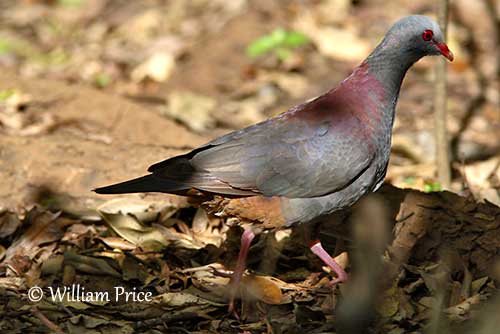Fr: Colombe de Gundlach
Ang: Grey-fronted Quail-Dove - Grey-headed Quail-Dove
All: Graukopf-Gundlachtaube
Esp: Paloma Perdiz Camao
Ita: Tortora quaglia frontegrigia
Nd: Grijskopkwartelduif
Sd: kubansk vaktelduva
Photographer:
William Price
PBase-tereksandpiper & Flickr William Price
Text by Nicole Bouglouan
Sources:
HANDBOOK OF THE BIRDS OF THE WORLD vol 4 by Josep del Hoyo-Andrew Elliott-Jordi Sargatal - Lynx Edicions - ISBN: 8487334229
PIGEONS AND DOVES by David Gibbs, Eustace Barnes and John Cox - Pica Press Sussex - ISBN: 1873403607
BIRDS OF THE WEST INDIES – by Herbert Raffaele, Kristin Williams et Tracy Pedersen – Helm – ISBN: 9780713649055
Cuba Explorer - Birds of Cuba - Endemic and near endemic birds of Cuba
Neotropical Birds – Cornell Lab of Ornithology
Grey-fronted Quail-Dove
Geotrygon caniceps
Columbiformes Order – Columbidae family
INTRODUCTION:
The Grey-fronted Quail-Dove is a plump terrestrial dove in the large family Columbidae. The genus Geotrygon includes the long-legged terrestrial doves with brown to purplish-brown body plumage often with green or purple iridescence, and distinct facial pattern.
This species is endemic to Cuba, but it is usually rare and local.
The Grey-fronted Quail-Dove has declining population, threatened by habitat loss and hunting pressure. It is currently classified as Vulnerable.
DESCRIPTION OF THE BIRD:
Biometrics:
Length: 26-30 cm
Weight: 192-210 g
The Grey-fronted Quail-Dove has dark grey plumage overall with bluish and purplish iridescence on mantle and back, whereas wings are olive to greenish-brown. Rump and uppertail-coverts also show bluish gloss, but the tail is blackish-brown.
On the head, the white forehead turns bluish-grey on crown and nape, with slight purplish tinge on back of head. The face is mostly ashy-grey, extending to throat and breast. The upper belly is whitish whereas lower belly, undertail-coverts and flanks are rufous. Underwing-coverts and axillaries are reddish-brown and the undertail is blackish-brown.
The bill is dull red. The eyes are red-orange, surrounded by narrow, dull red eyering. We can see a narrow, dull red loral line too. Legs and feet are dull coral-red.
The female is duller than male with less iridescence during the breeding season. She is slightly smaller too.
The juvenile is duller and darker olive-brown overall, with buff-fringed feathers on scapulars and wing-coverts. The underparts are chestnut-brown. The eyering is dull reddish-purple. Legs and feet are dull red.
RANGE:
The Grey-fronted Quail-Dove is resident in Cuba. It is mainly found in Zapata Peninsula and Sierra del Rosario.
HABITAT:
The Grey-fronted Quail-Dove frequents humid tropical and subtropical forests, up to 1500 metres of elevation. It favours undisturbed dense understorey with adjacent swamps. But it also frequents drier land with permanent small pools.
This species is sometimes recorded in mid-elevation and highland forests, up to 1850 metres on Pico Turquino.
CALLS AND SONGS: SOUNDS BY XENO-CANTO
The Grey-fronted Quail-Dove’s song is a long series of short, high-pitched “haooo” rapidly repeated, or a prolonged, lower-pitched “caoooo” regularly repeated.
Calling may occur year-round, but the bird is usually less vocal between May and September, during the wet season. It typically sings from a branch.
BEHAVIOUR IN THE WILD:
The Grey-fronted Quail-Dove feeds on fruits and seeds taken from the ground, often in mid-elevation forest. It also catches insects, grubs and caterpillars found in the leaf-litter and undergrowth.
It usually forages alone or in pairs. It is a shy and inconspicuous bird.
During the breeding season, the male performs the typical displays of Columbidae. While approaching a female (or a rival) the male raises its tail and spreads the wings. Another display shows the male performing courtship feeding to a potential mate, by dropping some food in front of her while fluttering the wings and spreading the tail. During this period, the male sings day-round from low perches or from the ground.
The Grey-fronted Quail-Dove is resident in Cuba.
The flight is swift and direct. If disturbed, it flies up to a low branch. The broad wings give it great manoeuvrability during the flight.
REPRODUCTION OF THIS SPECIES:
The breeding season takes place from January to August. The nest is a flimsy platform of twigs and leaves, sometimes lined with rootlets or grasses. It is built in dense bush or low undergrowth, usually 1-3 metres above the ground.
The female lays 1-2 buffy-white eggs. The incubation lasts 13 days. The chicks fledge 12-13 days after hatching, but they can be seen clambering out of nest into dense vegetation at 10 days old.
PROTECTION / THREATS / STATUS:
The Grey-fronted Quail-Dove is threatened by habitat loss due to expansion of cacao, coffee and tobacco plantations. During the dry season, burning, drainage, agriculture expansion and introduced predators threaten the species in the Zapata Swamps. It is also affected by hunting pressure.
The population is estimated to number 1,500/7,000 mature individuals and is declining due to the previous threats.
The Grey-fronted Quail-Dove is currently classified as Vulnerable.
